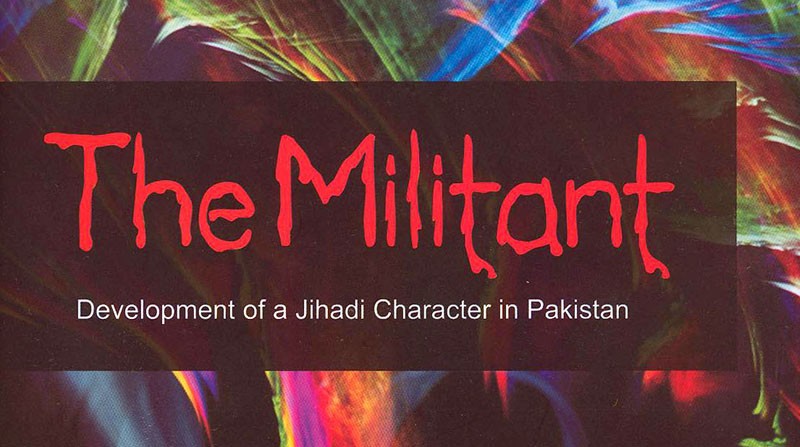
A good compendium of historical, religious and ideological insights into the terrific corruption of religion that makes up a militant worldview

For traditional Muslims, the militancy which Pakistan is beset with is heretical and has no religious, spiritual or political standing in Islam. Abandoning one’s upbringing and committing an overt act of killing as a form of worship is often beyond people’s comprehension. Many succumb to making assertions about the militants with no basis in reality. Against this backdrop, Muhammad Amir Rana’s book, The Militant: Development of a Jihadi Character in Pakistan, helps us recalibrate our misperceptions of the militant.
Written in a form best suited to non-governmental organisations’ reports, the book does not introduce us to the writer, and chooses to keep the flaps blank. For prospective readers of the book, however, Muhammad Amir Rana is a security and political analyst and the director of Pakistan Institute for Peace Studies (PIPS), an independent Islamabad-based think tank.
Rana has worked extensively on issues related to counter-terrorism, counter-extremism, and internal and regional security and politics and so, is qualified enough to reveal to us the inner dynamics of the myriad of justifications that militants or militant groups use to qualify their choice of taking up the gun.
The book is a good compendium of historical (recent), religious and ideological insights into the terrific corruption of religion that makes up a militant worldview. Its annexes carry details on religious parties and their student or youth wings of all hues; conventional militant groups; and major violent sectarian groups. The book uses a clear, crisp style that masterfully balances detail -- backed by the tables -- with readability. It defines militancy and helps us form a framework needed to counter it. It forges a new pathway to understand the transition of groups from the generally peaceful to the more oratorical/socially active radicals to the radical armed militants and back. It gives us an understanding of not only the militants but what belief system makes them so desperate to engage in asymmetric combat at the cost of their own lives.
Focusing on the development of the militant’s character in recent years, the book discovers that the phases of militant discourse have changed "his" personality. Wonder whether the book could also shed light on extremist groups espousing militancy casting their seductive shadows on women.
The book shows that while the militant of the 1990s was "adventurous", the militant in the making now has "clarity of ideology and objectives". It bins the stereotypical image of a militant saying "these approaches see militants from different viewpoints, varying from national security paradigms to strategic perspectives". "He can be well educated, even a graduate of a modern educational institution, be modest, accommodating and well-behaved in his personal life and well aware of societal and cultural norms," the book says.
The Militant shows the futility of banning the militant groups; they themselves or their splinters transform themselves into a rather more lethal and unmanageable entity. "Now the militant landscape is passing through a third phase of transformation…these militants are absorbing the influences of newly emerging militant organizations, such as the Islamic State of Iraq and Syria (ISIS)," the book says. "The ISIS model showed them the importance of controlling territory in order to project and establish power on the ground".
In this context, the book points to the irony of a state’s dependence on militants. "Even when the latter [the militants] are no more willing to serve as proxies, the former [the state] continues to treat them as such." "When the Afghan Taliban initiated negotiations with the US through their separate channels, they refused to accept direct Pakistani involvement in the peace process. … Also the Haqqani network that is depicted as being a strategic asset of Pakistan, have remained reluctant to use their influence over Pakistani militants to stop terrorist attacks in Pakistan."
The militants from the first generation had many options to return to their pre-militancy life because they were engaged in a jihad that was affirmed by the state and the society. But reintegrating the second and the third generations of militants may not be so simple.
The book is exquisite and disturbing at the same time in drawing attention to the reality of how much delicacy and risk go into building the machinery of change. It comes up with a reintegration model but also dilates upon the risks involved in acting upon it. It talks of the measures different states in the world have opted for in tackling militancy but points out that "the context in Pakistan is different and the challenge of religious militancy dissimilar to ethnic, nationalist and separatist movements".
Experts say that countering terrorism needs an approach that focuses not just on confronting it through the coercive apparatus of the state but also through disengagement strategies. The issue cannot be resolved either through dialogue with militants or through military operations alone. The government needs rather to follow through with a comprehensive response plan as envisaged in its National Internal Security Policy. A de-radicalisation centre is rehabilitating the youth of the affected areas of Swat since 2011. According to the military authorities more than 2, 200 youth have been reintegrated into the society till now.
But the problem with flawed ‘rehabilitation’ of hardcore militants is evident here.
In September 2014, Asmatullah Muawiya -- head of the Tehreek-i-Taliban Punjab -- announced that he and his faction would no longer carry out attacks in Pakistan and following through on his declaration surrendered to military officials in Miramshah in North Waziristan. A Taliban video explained how Muawiya would now devote his resources to fighting Nato forces in Afghanistan, as well as being involved in ‘Dawah and Tableegh’ [preaching] in Pakistan. How would his new course benefit the country is anybody’s guess!